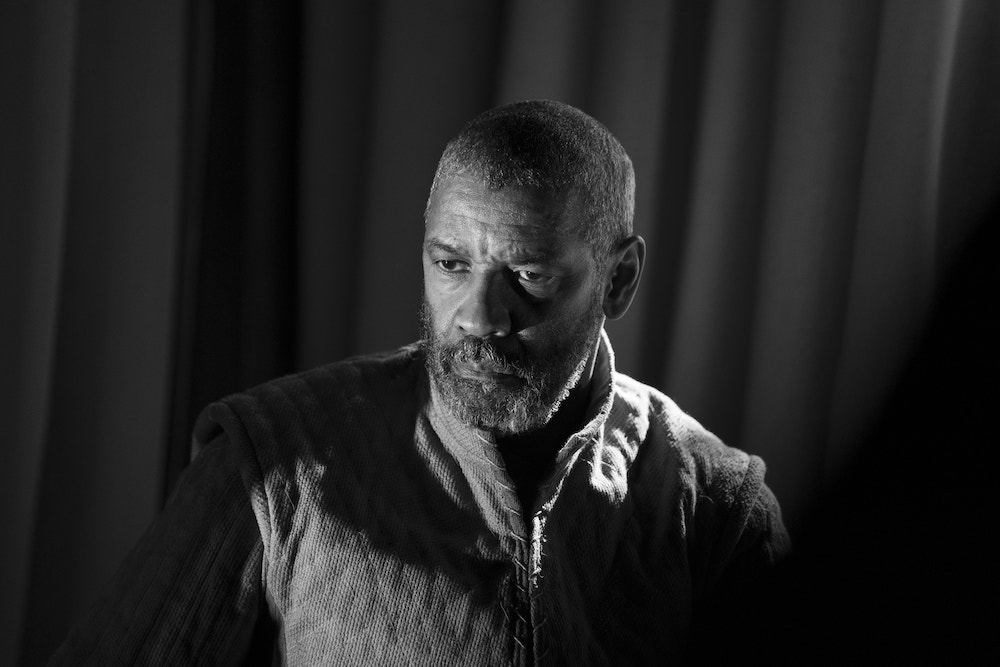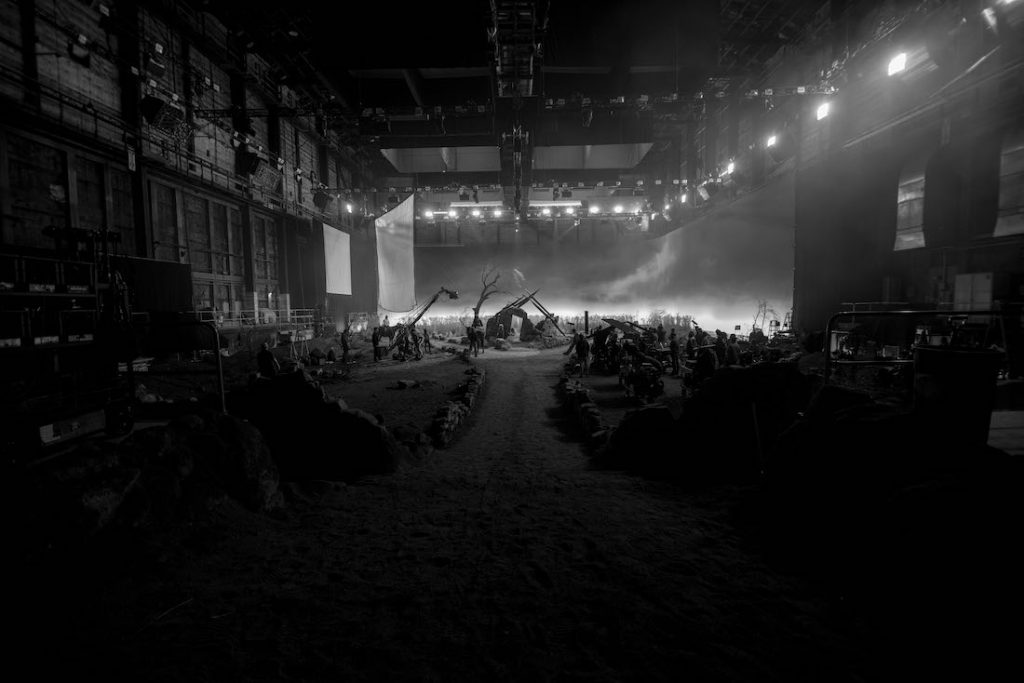
Production designer Stefan Dechant has worked on films including The Call of the Wild, Kong: Skull Island and Jarhead — projects he describes as “pretty straight-on reality-based,” aside from the occasional giant ape.
But a few years ago, he watched Francis Ford Coppola’s 1992 Bram Stoker’s Dracula, a film that revels in artifice.
“Man, I want to do something like that,” he remembers thinking. “The references to Faust, all these classic symbolism paintings — I’d love to dig into something like that.”
A week later, Dechant received a call about a new adaptation of Shakespeare’s Macbeth from Joel Coen, making his first directorial outing without his brother Ethan. Coen’s wife, Frances McDormand, would produce and star as Lady Macbeth. Denzel Washington was the king-slayer Macbeth. French cinematographer Bruno Delbonnel, a veteran of the Coens’ Inside Llewyn Davis and The Ballad of Buster Scruggs, would shoot the film.
Dechant joined the production 11 weeks out from shooting. He knew from his first meeting with Coen that his chance to make something more openly engaging with artifice had finally arrived.
“Somewhere in the universe, I was calling out to it and somehow it answered,” he says. “Not to get all Oprah about it. It just felt right.”
Below, Stefan Dechant explains his work in The Tragedy of Macbeth. —C.H.
As Told To Caleb Hammond

When I first sat down with Joel and his producer, Bob Graf, Joel said, Listen, this is going to be very stylized. Think German Expressionism, and know that sometimes a castle is not really a castle. Joel never wanted to deny that the original text of Macbeth was a theatrical text. It was meant to be presented in front of a live audience. He didn’t want to lose that, yet he was not interested in filming it as a play.
He and Bruno had been working on the imagery for probably close to a year before I started. They had built up a collection of images, and we went through them: This is Inverness. This is Dunsinane. This is the crossroads.
Some were frame grabs from different films: Carl Dreyer’s Passion of Joan of Arc was a major touchstone, Night of the Hunter, some Fritz Lang was in there, Hitchcock’s Rebecca.
It’s not a castle, it’s the idea of a castle. How do we make that work? We started having conversations about what the German Expressionists were doing. What was going on in Dreyer’s filmmaking? Joel showed me a black-and-white image by Hiroshi Sugimoto of Casa Luis Barragán. To me, that is Inverness.
If you think about Akira Kurosawa’s Ran, the man didn’t think he was going to be able to make that movie, so he painted the entire film — he had a way to express himself. So for Joel and Bruno, these images were a way for them to express what that film was in their minds. And then my job was to start creating more imagery, and reflect that movie back at them, and go: Are we in the right ballpark? And then start creating those spaces and that world-building that can hold Joel’s film. The sets don’t exist as a reality. Nothing in there has anything to do with 11th-century Scotland — nothing.
A lot of the sets don’t have a life before or after what happens in there. If you take a look at where the second series of apparitions takes place, Denzel is in that small room and he looks up and he sees the witches in the rafters. That set is only designed to contain those shots, and to contain those ideas that are going on for that scene. So everything from the set dressing to the props — those are the only items that are there. That’s all that exists. It was there for that scene, and the design of the set is to look up and to see the witches and for the environment itself to become a cauldron.
So instead of the honesty of the set being thought about as the honesty of the world that it’s being created in, it’s about the honesty of the scene that’s taking place in there.
When you start working, you dig into the knowns, and you put people on them. Let’s start getting these things up and going, so we can get it in front of the director.
![The Second Apparition Chamber in The Tragedy of Macbeth - Photo courtesy of Apple[SLASH]A24](https://www.moviemaker.com/wp-content/uploads/2022/01/The-Second-Apparition-Chamber-in-The-Tragedy-of-Macbeth-Photo-courtesy-of-AppleSLASHA24-1024x683.jpg)
That second apparition room was an unknown. I was working with a set designer and we had Joel’s photographs. So we had Xeroxed them and had them on the walls. Nothing, per se, was that room.
But there was one photograph, where one day I just went in, and was like, I don’t know what this is. I took a Sharpie, and I kind of drew the room, as it comes out now, onto that image. I had a talented set designer who was able to go: I think I know what you’re saying. He modeled that room up and it didn’t really change much.
We got it going, and we liked how the rafters were working for the witches. We did a couple of illustrations. I was holding them because I wasn’t comfortable showing them to Joel yet. But all this stuff was on our server. One day Joel came into my room and goes, I like the apparition room. I think that’s working. So he had seen it by just digging through our files and looking at it.
From there it becomes about refinement, ridiculous things like, What’s the average wingspan of a raven? to make sure it can get through the window. All that kind of nonsense. But what you really want to do is preserve the integrity of the emotional portion of the design.
You’re always building a set to be shot. But in The Tragedy of Macbeth, the cinematography defines the parameters of the set, in terms of what its construction is, because it’s not just that it’s made out of wood and plaster and all these other materials — it’s carved out of light and shadow.

When Joel was talking about abstracting the imagery in that initial meeting, the first way to do that is by going to black and white. That’s what led to the Expressionism of it. Right away, even the aspect ratio was set at Academy ratio — 1.37:1. That was the foundation, and then conversations came later, especially with Bruno, about painting shadows into the sets. Let’s start gradating as we go into corners, let’s start painting the undersides of arches darker, and put our own shadows in there. You can probably do that stuff in color. But you sure as hell can get away with a lot more in black and white.
Also read: The French Dispatch: This 1962 Orson Welles Film Inspired the Prison Design
We were always playing with those shadows, and the darkness in there, and how far we could push it. Eventually, I started going from mid-level gray into black. Once Bruno lit a set, that black would become maybe 50 percent gray. So that apparition room with the witches up there in the rafters — that goes to full black to the top. And then when it’s lit, you get the textures in there. That’s where you just have to trust your DP. And if it’s Bruno, you just believe him — he’s brilliant. When he goes that dark, it will be fine.
The Tragedy of Macbeth, directed by Joel Coen with production design from Stefan Dechant, is available to stream on Apple TV+ on Friday.
Main image: Joel Coen and Frances McDormand on set of The Tragedy of Macbeth. Photos courtesy of Apple/A24.
